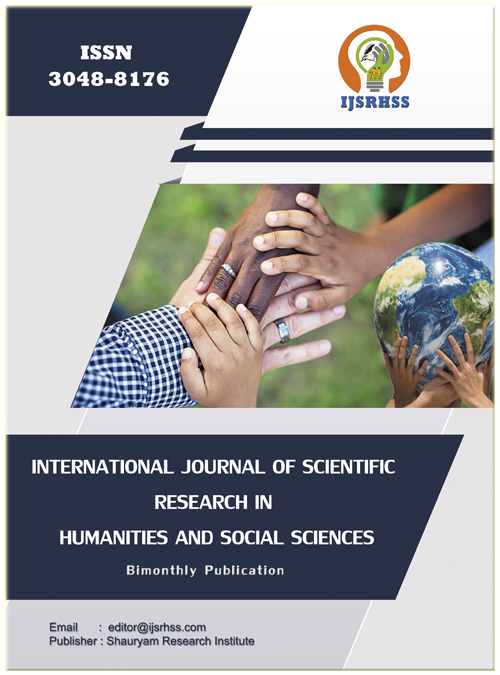A Comparative Study on Gender and Fantastical Figures in Tolkien and Martin
DOI:
https://doi.org/10.32628/IJSRHSS252522Keywords:
Patriarchy, Gender Roles, Feminism, Fantasy, LiteratureAbstract
Most of us are introduced to fairy tales and fantastical elements when we are growing up. We read the stories of warriors and princesses, dragons and demons, elves and dwarves, but what we do not realise at the moment is that the stories that we read in our childhood contain a deeper meaning behind them, as they portray the ideas of gender roles. While many studies have explored gender representation in fantasy literature, few have analysed how gender is constructed through an intersectional lens in both children’s stories and adult fiction. Which is why, understanding the portrayal of gender in these distinct literary categories offers deep insights into the sociocultural factors which influences character development and narrative structures. However, research comparing gender roles in Tolkien’s children's literature and Martin’s adult fiction remains limited. The main objective of this comparative study is to examine the intersection of gender with class, race, and power in J.R.R. Tolkien’s The Hobbit and The Lord of the Rings and George R.R. Martin’s A Song of Ice and Fire series. Drawing from feminist and intersectional theory, this study analyses how both authors depict gender roles, considering the impact of target audience and genre conventions. Data is gathered through textual analysis, focusing on key characters and their roles within the social and political hierarchies of their respective worlds. The analysis reveals that Tolkien’s characters embody more traditional, simplified gender roles with limited intersectionality, while Martin’s characters exhibit complex gender identities shaped by overlapping factors of power, class, and race.
Downloads
References
Tolkien, J.R.R. - Middle-Earth Books
Tolkien, J.R.R. The Hobbit. George Allen & Unwin, 1937.
--- The Fellowship of the Ring. HarperCollins, 2001.
--- The Two Towers. HarperCollins, 2001.
--- The Return of the King. HarperCollins, 2001.
Martin, George R.R. - A Song of Ice and Fire Series
Martin, George R.R. A Game of Thrones. Bantam Books, 1996.
--- A Clash of Kings. Bantam Books, 1999.
--- A Storm of Swords. Bantam Books, 2000.
--- A Feast for Crows. Bantam Books, 2005.
--- A Dance with Dragons. Bantam Books, 2011.
Alvarez, Sandra. “Androgynes, Crossdressers, and Rebel Queens: Modern Representations of Medieval Women Warriors from Tolkien to Martin.” Medievalists.net, 2013, www.medievalists.net.
Croft, Janet Brennan, and Leslie A. Donovan, editors. Perilous and Fair: Women in the Works and Life of J.R.R. Tolkien. Mythopoeic Press, 2015. https://scholar.valpo.edu/cgi/viewcontent.cgi?article=1019&context=journaloftolkienresearch
Doughnan, Keith. Stereotypes of Race and Gender in J.R.R. Tolkien’s The Lord of the Rings from an Intercultural Perspective. M.A. thesis, Østfold University College, 2016. https://hiof.brage.unit.no
Darga, Amanda. Tolkien’s Women: An Analysis of Female Characters in the Work of J.R.R. Tolkien. University of Michigan, 2017. https://lsa.umich.edu/content/dam/english-assets/migrated/honors_files/DARGA%20Tolkiens%20Women.pdf
Suwalska‑Kołecka, Dorota. “Gender and Power Relations in J.R.R. Tolkien’s Middle‑Earth.” Academic Journal of Modern Philology, no. 12, 2020, pp. 71–88. Central and Eastern European Online Library, https://www.ceeol.com/search/article-detail?id=1026534
Casey, Sarah. Exploring Femininity in Middle‑Earth: Tolkien’s Female Characters and Their Impact. University of Nebraska–Lincoln, 2017. https://digitalcommons.unl.edu/cgi/viewcontent.cgi?article=1033&context=ureca
Rollin, Melissa. “J.R.R. Tolkien’s Portrayal of Femininity and Its Transformations in Subsequent Adaptations.” Academia.edu, 2019, https://www.academia.edu/40972248/J_R_R_Tolkien_s_Portrayal_of_Femininity_and_Its_Transformations_in_Subsequent_Adaptations
Kreidler, Katie. “George R.R. Martin’s Women in A Song of Ice and Fire.” Academia.edu, 2011, https://www.academia.edu/1835290/George_R_R_Martins_Women_in_A_Song_of_Ice_and_Fire
Amy‑Chinn, Dee, and Katie Monks. “Women of Ice and Fire: Gender, Game of Thrones, and Multiple Media Engagements.” Feminist Media Studies, vol. 16, no. 5, 2016, pp. 821–25. ResearchGate, https://www.researchgate.net/publication/301649619_Women_of_Ice_and_Fire_Gender_Game_of_Thrones_and_Multiple_Media_Engagements
Downloads
Published
Issue
Section
License
Copyright (c) 2025 International Journal of Scientific Research in Humanities and Social Sciences

This work is licensed under a Creative Commons Attribution 4.0 International License.




